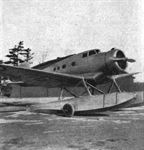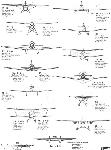
Northrop Delta
Параллельно с разработкой самолета Gamma специалисты "Northrop" работали над девятиместным транспортным монопланом, который сочетал в себе новый фюзеляж и крыло от Gamma. Впрочем, в закон об авиационной коммерции США от 1926 года (US 1926 Air Commerce Act) были внесены поправки, запрещающие использовать одномоторные самолеты для перевозки пассажиров ночью или над пересеченной местностью, где невозможно совершить аварийную посадку. Это стало ударом для компании-разработчика. С другой стороны три машины уже были проданы, а остальные 8 самолетов использовались как административные и еще два были приобретены шведской компанией "AB Aerotransport". Береговая охрана США использовала модель Delta под обозначением RT-1 как персональный самолет министра финансов. Последний самолет Delta был поставлен в Канаду как сборочный образец и как эталон для компании "Canadian Vickers", которая выпустила 20 самолетов различных модификаций как с колесным, так и с поплавковым шасси. Самолеты Delta оснащались различными двигателями, включая Wright SR-1820 мощностью 710 л. с. и 735 л. с., Pratt & Whitney Hornet мощностью 650 л. с., 660 л. с. и 700 л. с.
Описание:
- Northrop Delta
- Flight, February 1934
THE LATEST NORTHROPS
Фотографии
-
Мировая Авиация 208
Регистрационный номер: SE-ADI Этот SE-ADI - первый самолет Delta 1C, приступивший к полетам в шведской авиакомпании "AB Aerotransport". Он получил собственное имя "Holland". Гонки 1934 года на Кубок Мак-Робертсона для него оказались неудачными.
-
Air Pictorial 1956-05
A rare photograph of a licence-built (Canadian Vickers Ltd ., Montreal) Northrop Delta Mk.la of the R.C.A.F., serial 667. The trousered main wheels were often replaced by a twin-float, multi-strut braced gear, for operations on the many Canadian lakes. Delta Mk.la's were used by No. 8 Squadron, R.C.A.F., for reconnaissance and transport duties. Bomb-carriers could be mounted under the all-metal wings. With a crew of two the Delta could take six passengers cruising at 160 m.p.h. Power: a 575-h.p. Wright Cyclone radial. One Delta Model I-D (N13777) is still flying in the U.S.A.
-
Jane's All the World Aircraft 1980 / Encyclopedia of Aviation - Aircraft A-Z - v5
Регистрационный номер: NC13777 Northrop Delta.
-
Air Enthusiast 1972-12 / In print
A Northrop 1-D Delta in Nationalist service as 43-5, this aircraft having been captured aboard the Mar Cantabrico which was attempting to run the Nationalist blockade.
-
Flight 1934-02 / Flight
Регистрационный номер: NC12292 THE NORTHROP "DELTA": Note the generous fillet at the junction of the wing and fuselage.
-
Flight 1938-03 / Flight
Both the Grumman JF-2 and the Northrop Delta have the Wright Cyclone engine.
-
Flight 1933-12 / Flight
The Northrop "Delta," as supplied to A.B.A.
-
Flight 1934-09 / Flight
THE SWEDISH TEAM: The Northrop "Delta" Holland, and its crew, M. Lindholm (left) and G. Lindow.
-
Flight 1934-02 / Flight
Регистрационный номер: X-ABED -
Jane's All the World Aircraft 1938 / 03 - All the world's aeroplanes
The Canadian Vickers-Northrop "Delta" Seaplane (Wright "Cyclone" engine).
-
Flight 1939-02 / Flight
A Northrop Delta - one of two built by the Canadian-Vickers concern for general-purpose work.
-
Flight 1937-09 / Flight
ANGLO-CANADIAN-AMERICAN: One of two Northrop Delta cabin floatplanes built under licence by the Canadian Vickers firm for the Royal Canadian Air Force. The engine is a 750 h.p. Wright Cyclone F.
-
Flight 1934-10 / Flight
Другие самолёты на фотографии: Bellanca 28 Flash - США - 1934De Havilland Comet / D.H.88 - Великобритания - 1934De Havilland Fox Moth / D.H.83 - Великобритания - 1932De Havilland Leopard Moth / D.H.85 - Великобритания - 1933Fairey Fox - Великобритания - 1925Harkness & Hillier All Australian - Австралия - 1934Lockheed Sirius / Altair 8 - США - 1929Lockheed Vega - США - 1927Miles Falcon M.3 / Hawcon M.6 - Великобритания - 1934Monocoupe 90 / 110 / 145 - США - 1930Percival Gull - Великобритания - 1932Short Scion / S.16 - Великобритания - 1933
-
Flight 1934-02 / Flight
Northrop Delta
- Фотографии













